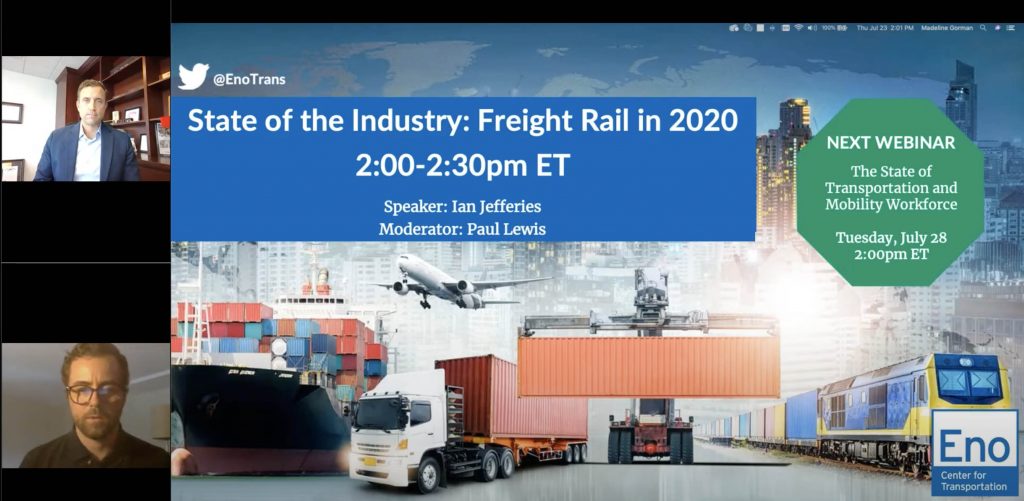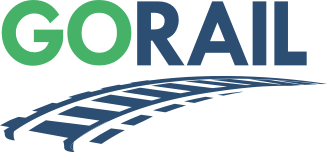“Railroading—it’s been around for a long time. We’ve been through a lot and we’ll get through this strong and continue to keep serving for America.”
That was the central takeaway offered by Association of American Railroads President and CEO Ian Jefferies during a July 23 webinar hosted by the Eno Center for Transportation. The event, attended by over 500 virtual viewers, explored the state of the freight rail industry in 2020 as it faces operational and financial challenges due to the pandemic.
Freight railroads have adapted to keep traffic moving, noted moderator Paul Lewis, vice president of policy and finance at Eno, as he asked Jefferies about the outlook for rail.
 “Freight rail, like every other industry in America, was hit pretty substantially, and continues to be affected by the COVID-19 pandemic,” said Jefferies. Railroads have seen decreases across all commodity sectors they serve, including energy products, consumer goods and automobiles. At its lowest point, Jefferies said, traffic experienced a 25% drop-off.
“Freight rail, like every other industry in America, was hit pretty substantially, and continues to be affected by the COVID-19 pandemic,” said Jefferies. Railroads have seen decreases across all commodity sectors they serve, including energy products, consumer goods and automobiles. At its lowest point, Jefferies said, traffic experienced a 25% drop-off.
But recent weeks have brought a more positive outlook for traffic, particularly in intermodal, including consumer products and ecommerce.
“What we’ve seen is a gradual tick-back,” said Jefferies. “UPS is the largest customer for the industry writ large, and certainly ecommerce has thrived during the pandemic. I know in my house it seems like we’re receiving a handful of packages every day, and a lot of those end up on the rails at some point.”
Freight rail’s resiliency—built by steady private investments year over year—is a key factor in how it’s responded to the crisis, said Jefferies. Even during a significant economic downturn, railroads must undertake a certain level of core maintenance and 2020 is no exception, with these companies plowing ahead on planned projects and even taking advantage of lulls in traffic to get ahead of schedule according to Jefferies.
“One of the things I’m most proud of is that, unlike a lot of other industries, we have not had to go to the federal government seeking direct funding or financial support,” said Jefferies. “That’s due to that sustained investment, that’s due to that well-capitalized nature that allows us to continue to operate in good times and bad and continue to serve our customers in whatever capacity they need.”
Though the pandemic has added a renewed level of urgency to the industry’s policy agenda, rail’s overarching public policy goals have remained constant. These goals center around maintaining a smart, balanced approach to economic regulation, one that “allows us to operate in a market-based reality,” offered Jefferies.
Indeed, freight rail’s resilience throughout the pandemic is an example of why this regulatory model, enshrined by the Staggers Act 40 years ago, works. Freight railroads are in a position where they’re investing about $25 billion annually into the nationwide network, not living from extension to extension, Jefferies emphasized.
Another main policy objective is maintaining the ability to develop and deploy new technologies on the safety and operational fronts—and making sure that regulations evolve with new technologies to ensure railroads can stay competitive. Jefferies pointed to advances in rail monitoring and detection systems that allow companies to identify potential problems before an incident happens.
Other factors, like the implementation of precision scheduled railroading (PSR) over recent years, have helped railroads meet customer needs throughout the pandemic. Jefferies noted that PSR, the core tenets of which include maximizing asset utilization, increasing efficiency and providing a more just-in-time product, has positioned railroads better for the current moment than they would have been years ago.
“We’re riding this out like everyone else—and doing it from a position of strength.”


